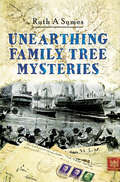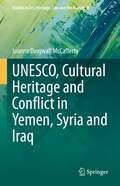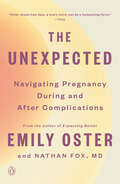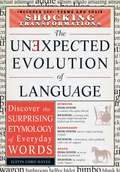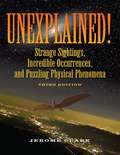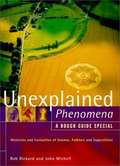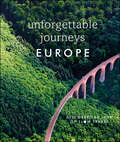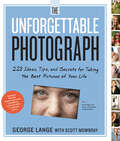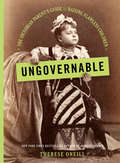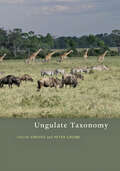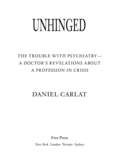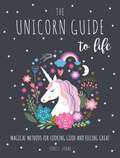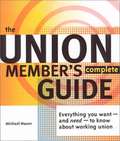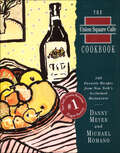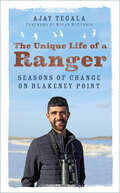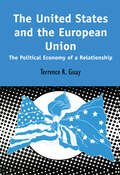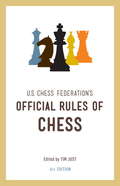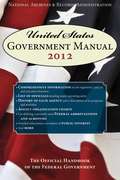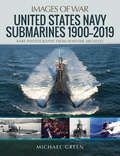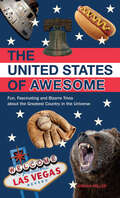- Table View
- List View
Unearthing Family Tree Mysteries
by Ruth A. SymesThe intriguing characters in these real family history mysteries include an agricultural labourer who left secrets behind in Somerset when he migrated to Manchester, a working-class woman who bafflingly lost ten of her fourteen children in infancy, a miner who purportedly went to live with the Red Indians and a merchant prince of the Empire who was rumoured to have two wives. This book shows how a variety of sources including birth, marriage and death certificates, censuses, newspaper reports, passports, recipe books, trade directories, diaries and passenger lists were all used to uncover more, and how much can be detected by setting the characters from your family tree in their proper historical backgrounds.This book is an updated edition of Ruth Symes previous book, titled Stories From Your Family Tree: Researching Ancestors Within Living Memory (2008).
UNESCO, Cultural Heritage and Conflict in Yemen, Syria and Iraq (Studies in Art, Heritage, Law and the Market #8)
by Joanne Dingwall McCaffertyThis book aims to determine UNESCO's capability to facilitate heritage protection measures pre-conflict, emergency response measures during conflict and reconstruction efforts post-conflict. The book employs document analysis to ascertain UNESCO's legal obligations when it comes to facilitating cultural heritage protection in its Member States' territories in the condition of armed conflict, while drawing comparisons with the reality of the organisation's presence and involvement in Yemen, Syria and Iraq. This study maps shifts in UNESCO's level of communication with each country's respective government and civil authorities; allocation of financial, human and material resources; and implementation of heritage safeguarding and reconstruction initiatives. Both quantitative and qualitative data shows UNESCO to exhibit great inequity in engagement, at times, closing communications entirely with Syria, due to the political standpoints of other UNESCO Member States. This political gridlock is often shown to result in the organisation overstating its ability to safeguard or restore heritage, with promises not being followed up with action. Since 2015, UNESCO has expressed a stronger intent to be a key player in heritage protection during armed conflict, however as long as cultural heritage protection is not considered a humanitarian concern, UNESCO will not be able to circumvent much of the political and bureaucratic barriers facing intergovernmental organisations during conflict, which prevent emergency action from being implemented. In order to ensure heritage safeguarding is permitted during periods of significant unrest, regardless of political discord, it is crucial that UNESCO promote a people-centred approach to its cultural heritage protection initiatives. This book evidences that focusing on livelihoods and meaningful and practical connections between populations and their local heritage to be UNESCO's optimal methodological approach for justifying cultural heritage protection as a humanitarian necessity. The book's readership includes academics, researchers, and practitioners in the fields of political science, law and heritage studies.
The Unexpected: Navigating Pregnancy During and After Complications (The ParentData Series #4)
by Emily Oster Nathan FoxFrom the New York Times bestselling author of Expecting Better, a guide to navigating a second pregnancy when the first did not go as planned—with Dr. Nathan Fox, maternal fetal medicine specialistIn Expecting Better, Emily Oster revolutionized the pregnancy landscape with her data-driven approach. In the years since, she kept hearing questions from readers on how to approach a second pregnancy when the first has not gone as planned.While The Unexpected is a book that Oster hopes no one needs, the reality is that 50 percent of pregnancies include complications, a fact we don&’t talk about. Preeclampsia, miscarriage, hyperemesis gravidarum, preterm birth, postpartum depression: these are lonely experiences, and that isolation makes treatment harder to access—and crucial research and policy change less likely to happen.The Unexpected lays out the data on recurrence and treatments shown to lower or mitigate risk for these conditions in subsequent pregnancies. It also provides readers road maps to facilitate productive conversations with their providers, with insights from lauded maternal fetal medicine specialist Dr. Nathan Fox.By bridging the knowledge gap and making space for difficult conversations, The Unexpected promises to make the hardest parts of pregnancy a little bit less so.
The Unexpected Evolution of Language
by Justin Cord HayesThis book is awesome awful!Did you know that "awful" first originated as a compliment? How about the fact that it was perfectly fine for someone to defecate in their living room? Or that at one time a bully was actually a sweetheart?You may think that these things sound outlandish, but hundreds of years ago, the words "awful," "defecate," and "bully" meant something entirely different than what we know today. The Unexpected Evolution of Language reveals the origins of 208 everyday terms and the interesting stories behind their shift in meaning.Arranged in alphabetical order, you will enjoy uncovering the backstories to terms like:Awful - worthy of respect or fear; inspiring aweBimbo - slang for a stupid, inconsequential manDefecate - to purify; cleanseInvest - to clothe; to dressNice - foolish; stupidRelay - hunting term meaning fresh pack of houndsFrom "aftermath" and "sophisticated" to "empty" and "prestige," you will aboslutely love seeing just what kind of damage time has done to the English language.
The Unexpected Evolution of Language: Discover the Surprising Etymology of Everyday Words
by Justin Cord HayesThis book is awesome awful!Did you know that "awful" first originated as a compliment? How about the fact that it was perfectly fine for someone to defecate in their living room? Or that at one time a bully was actually a sweetheart?You may think that these things sound outlandish, but hundreds of years ago, the words "awful," "defecate," and "bully" meant something entirely different than what we know today. The Unexpected Evolution of Language reveals the origins of 208 everyday terms and the interesting stories behind their shift in meaning.Arranged in alphabetical order, you will enjoy uncovering the backstories to terms like:Awful - worthy of respect or fear; inspiring aweBimbo - slang for a stupid, inconsequential manDefecate - to purify; cleanseInvest - to clothe; to dressNice - foolish; stupidRelay - hunting term meaning fresh pack of houndsFrom "aftermath" and "sophisticated" to "empty" and "prestige," you will aboslutely love seeing just what kind of damage time has done to the English language.
The Unexpected Evolution of Language
by Justin Cord HayesThis book isawesomeawful! Did you know that "awful" first originated as a compliment? How about the fact that it was perfectly fine for someone to defecate in their living room? Or that at one time a bully was actually a sweetheart? You may think that these things sound outlandish, but hundreds of years ago, the words "awful," "defecate," and "bully" meant something entirely different than what we know today. The Unexpected Evolution of Languagereveals the origins of 208 everyday terms and the interesting stories behind their shift in meaning. Arranged in alphabetical order, you will enjoy uncovering the backstories to terms like: Awful- worthy of respect or fear; inspiring awe Bimbo- slang for a stupid, inconsequential man Defecate- to purify; cleanse Invest- to clothe; to dress Nice- foolish; stupid Relay- hunting term meaning fresh pack of hounds From "aftermath" and "sophisticated" to "empty" and "prestige," you will aboslutely love seeing just what kind of damage time has done to the English language.
Unexplained!
by Jerome ClarkDelivering the possible truths of more than 200 unexplained mysteries, this collection applies an authoritative, intelligent, and reasoned examination of strange artifacts and events that have perplexed scientists. It explores a wide range of phenomena, including cattle mutilations, crop circles, spontaneous human combustion, Martian lore, Roswell, Loch Ness, weather phenomena, fairies, Bigfoot, the Bermuda Triangle, living dinosaurs, ghosts, UFOs, pterodactyl sightings, flying humanoids, hollow earth, and other absorbing puzzles. Along the way, readers will learn of hoaxes, witness the creation of various modern myths, and learn of frightening personal accounts and startling historical documents. Documenting the evidence and hearing witnesses out, Jerome Clark brings an engaging narrative to the stories, objectively presents their many possible explanations, and lets the reader make his or her own judgment in this oneofakind book.
Unexplained Phenomena: A Rough Guide Special
by John Michell Bob RickardThis new title combines and updates two classic books ("Phenomena" and "Living Wonders") by the same authors. The original subjects of mysterious phenomena (including poltergeists, showers of objects and spontaneous human combustion) and crypto-zoology (including living ape men, the Loch Ness monster and dinosaurs in the Congo) has been joined by nine new sections covering subjects as diverse as vampires, crop circles and alien abductions.
Unforgettable Journeys Europe: Discover the Joys of Slow Travel
by DKInspirational travel book covering 150 of Europe's most incredible journeys, including routes on foot and by bike, road, rail and water. When it comes to beautiful landscapes, Europe has more than its fair share of icons. The snowy peaks of the Alps, the vivid tulip fields of the Netherlands and the glittering lakes of northern Italy – you&’ll find them nowhere else but here. Yet pause to look around a little longer, and you&’ll soon discover that these postcard favorites sit side by side with many more understated scenes that are just as stunning. In fact, the slower you go, the more treasures you&’ll uncover – so why would you want to rush the experience? Featuring over 150 inspirational entries, Unforgettable Journeys Europe is a vibrant celebration of taking the scenic route. We've picked the best adventures across the continent, from cruising around the Western Fjords of Norway to hiking the Lycian Way in Turkey. Of course, the big-hitters are covered – riding Switzerland&’s Glacier Express, ferry-hopping in Greece and cycling from Land&’s End to John O&’Groats – but we also take you off-the-beaten path, roaming the Albanian Riviera, kayaking through Finnish lakeland and navigating the steady switchbacks of the Transfagarasan Road in Romania. Make your next trip magical as you explore: - Over 150 incredible journeys illustrated with inspiring photography and maps that plot the routes and bring their highlights to life.- Chapter maps provide a handy overview of the locations covered.- Evocative text transports the reader there with vivid descriptions and fascinating stories.- Includes practical information, such as duration, difficulty, and start and end points.- Sustainable and slow travel options have been covered where possible.- Feature boxes give the routes context.- Gives suggestions for alternative ways to make the same journey and other destinations where you can enjoy similar trips.We&’ve organized the book by types of transport, so whether you&’re an avid hiker, cyclist or driver, or love to be on the water or on the rails, we&’ve got you covered. It&’s time to take the slow road and truly appreciate Europe in all its wonderful variety.
The Unforgettable Photograph: How to Take Great Pictures of the People and Things You Love
by George Lange Scott MowbrayRenowned photographer George Lange’s work is guided by one simple truth: An unforgettable photograph is not about what the subject looks like, but what it feels like. In this entirely new kind of photography guide, written by Mr. Lange and Scott Mowbray, magazine editor and longtime amateur photographer, the rest of us will learn how to take photographs that don’t just document life but celebrate it.No fancy equipment required. Just hundreds of simple, inspiring ideas and lessons—each one illustrated with a photograph—organized around the six essential principles of seeing like a photographer. (Here’s one: Shoot the Moment, Not the Subject.)Here’s why to shoot in natural light—always. The fun of putting babies in surprising places. How to get intimate with food. Using a dramatic sky as your backdrop. The benefit of learning to know the light in every room of your house. Shooting hands or feet instead of faces. How to move past the “I was here” postcard effect. How to catch the in-between moments. Because in the end, it’s about living the moment, shooting the moment—and being in the moment forever.
Ungovernable: The Victorian Parent's Guide to Raising Flawless Children
by Therese OneillFrom the author of the "hysterically funny and unsettlingly fascinating"* New York Times bestseller Unmentionable, a hilarious illustrated guide to the secrets of Victorian child-rearing [*Jenny Lawson] Feminist historian Therese Oneill is back, to educate you on what to expect when you're expecting . . . a Victorian baby! In Ungovernable, Oneill conducts an unforgettable tour through the backwards, pseudoscientific, downright bizarre parenting fashions of the Victorians, advising us on: - How to be sure you're not too ugly, sickly, or stupid to breed- What positions and room decor will help you conceive a son- How much beer, wine, cyanide and heroin to consume while pregnant- How to select the best peasant teat for your child- Which foods won't turn your children into sexual deviants- And so much moreEndlessly surprising, wickedly funny, and filled with juicy historical tidbits and images, Ungovernable provides much-needed perspective on -- and comic relief from -- the age-old struggle to bring up baby.
Ungulate Taxonomy
by Colin Groves Peter GrubbA group of special interest to mammalogists, taxonomists, and systemicists, ungulates have proven difficult to classify. This comprehensive review of the taxonomic relationships of artiodactyls and perissodactyls brings forth new evidence in order to propose a theory of ungulate taxonomy.With this straightforward volume, Colin Groves and the late Peter Grubb cut through previous assumptions to define ungulate genera, species, and subspecies. The species-by-species accounts incorporate new molecular, cytogenetic, and morphological data, as well as the authors’ own observations and measurements. The authors include references and supporting arguments for new classifications.A starting point for further research, this book is sure to be discussed and hotly debated in the mammalogical community. A well-reasoned synthesis, Ungulate Taxonomy will be a defining volume for years to come.
Unhinged: A Doctor's Revelations About a Profession in Crisis
by Daniel CarlatIn this stirring and beautifully written wake-up call, psychiatrist Daniel Carlat exposes deeply disturbing problems plaguing his profession, revealing the ways it has abandoned its essential purpose: to understand the mind, so that psychiatrists can heal mental illness and not just treat symptoms. As he did in his hard-hitting and widely read New York Times Magazine article "Dr. Drug Rep," and as he continues to do in his popular watchdog newsletter, The Carlat Psychiatry Report, he writes with bracing honesty about how psychiatry has so largely forsaken the practice of talk therapy for the seductive and more lucrative practice of simply prescribing drugs, with a host of deeply troubling consequences. Psychiatrists have settled for treating symptoms rather than causes, embracing the apparent medical rigor of DSM diagnoses and prescription in place of learning the more challenging craft of therapeutic counseling, gaining only limited understanding of their patients lives. Talk therapy takes time, whereas the fifteen-minute "med check" allows for more patients and more insurance company reimbursement. Yet DSM diagnoses, he shows, are premised on a good deal less science than we would think. Writing from an insider's perspective, with refreshing forthrightness about his own daily struggles as a practitioner, Dr. Carlat shares a wealth of stories from his own practice and those of others that demonstrate the glaring shortcomings of the standard fifteen-minute patient visit. He also reveals the dangers of rampant diagnoses of bipolar disorder, ADHD, and other "popular" psychiatric disorders, and exposes the risks of the cocktails of medications so many patients are put on. Especially disturbing are the terrible consequences of over-prescription of drugs to children of ever younger ages. Taking us on a tour of the world of pharmaceutical marketing, he also reveals the inner workings of collusion between psychiatrists and drug companies. Concluding with a road map for exactly how the profession should be reformed, Unhinged is vital reading for all those in treatment or considering it, as well as a stirring call to action for the large community of psychiatrists themselves. As physicians and drug companies continue to work together in disquieting and harmful ways, and as diagnoses and misdiagnoses of mental disorders skyrocket, it's essential that Dr. Carlat's bold call for reform is heeded.
The Unicorn Guide to Life: Magical Methods for Looking Good and Feeling Great
by Eunice HorneBring some sparkle into your life with this guide to work, rest and play – the unicorn way! Learn to spot the stars and rainbows in everyday life and celebrate the real you – a magical, unique being – with this a-mane-zing book!
Unified English Braille: Australian Training Manual
by Josie Howse Kathy Riessen Leona HollowayUnified English Braille (UEB) was adopted for use by the Australian Braille Authority (ABA) in May 2005; with an envisaged five year transition period. Since 2010, it has been Australia's only braille code in use. Following the adoption of UEB, our major braille producers commenced implementing the code almost immediately and an urgent need for teaching materials in the new, but still developing, braille code was created. Thus, the Unified English Braille Primer: Australian Edition followed shortly afterwards, with the Preliminary Edition in 2006 and an update in 2008. As time passed, the UEB code has been refined and the UEB rules are now articulated in The Rules of Unified English Braille: Second Edition 2013 ("The Rulebook" as it is commonly known).
The Union Member's Complete Guide: Everything You Want -- And Need -- To Know About Working Union
by Michael MauerAn easy-to-read, thorough explanation of what unions are, how they work, and the rights and responsibilities of membership.
The Union Square Cafe Cookbook: 160 Favorite Recipes from New York's Acclaimed Restaurant
by Danny Meyer Michael RomanoThe award–winning restaurant offers recipes revealing “what goes into the restaurant's mingling of French, Italian and other cuisines. . . . [I]mpressive” (Publishers Weekly).Union Square Cafe serves some of the most imaginative, interesting, and tasty food in America. Now its devoted fans can savor the restaurant's marvelous dishes, trademark hospitality, and warm decor at home.Offered are recipes for 160 of Union Square Cafe's classic dishes, from appetizers, soups, and sandwiches to main courses, vegetables, and desserts. Hot Garlic Potato Chips, Porcini Gnocchi with Prosciutto and Parmigiano Cream, Grilled Marinated Fillet Mignon of Tuna, Herb-Roasted Chicken, Eggplant Mashed Potatoes, and Baked Banana Tart with Caramel and Macadamia Nuts are some of the all-time favorites included in this long-awaited collection. Amateurs and pros alike will find the dishes here as accessible as they are irresistible.Beyond just providing recipes, The Union Square Cafe Cookbook inspires confidence in home cooks by sharing Michael Romano's tips for success. Danny Meyer's wine suggestions, inspired by the restaurant's remarkable cellar, accompany almost every recipe.Folks will still go out of their way to eat at Union Square Cafe, but this cookbook—filled with the restaurant's vitality, warm artwork, and tempting recipes—ensures that its pleasures are as close as your bookshelf.“The mix of Mediterranean cuisines, with occasional Asian overtones, yields pleasant surprises.” —Booklist“I know of no other restaurant in America where I have enjoyed more innovative, satisfying, and delicious meals than at Union Square Cafe and now I have the next best thing to eating there—the recipes!” —Robert M. Parker Jr.
The Unique Life of a Ranger: Seasons of Change on Blakeney Point
by Ajay TegalaFew people have had the privilege of living on an isolated nature reserve of international importance, their every move judged by countless critics. Young ranger Ajay Tegala, embarking on his placement at Blakeney Point aged just nineteen, would have to stand firm in the face of many challenges to protect the wildlife of one of Britain’s prime nature sites.In over 120 years, only a select few rangers have devoted their heart and soul to the wildlife of Norfolk’s Blakeney Point. Watching and learning from his predecessors, Ajay faced head-on the challenges of the elements, predators and an ever-interested public. From the excitement of monitoring the growing grey seal population, to the struggles of trying to safeguard nesting birds from a plethora of threats, in The Unique Life of a Ranger, Ajay shares the many emotions of life on the edge of land and sea with honesty and affection.
The United States and the European Union: The Political Economy of A Relationship (Contemporary European Studies Ser. #Vol. 8)
by Terrence R. GuayFirst Published in 2001. Routledge is an imprint of Taylor & Francis, an informa company.
United States Chess Federation's Official Rules of Chess, Sixth Edition (Chess)
by U.S. Chess FederationThis comprehensive rulebook is the only guide sanctioned and compiled by the U.S. Chess Federation (USCF), the governing body for chess in the United States. It is designed to be a useful reference for all chess players, especially tournament directors and chess club teachers.THIS NEW EDITION FEATURES THE LATEST RULES GOVERNING CHESS, INCLUDING:• Guidelines for Internet chess and speed chess• Information about the USCF&’s national chess ratingsystem• Explanations of all legal moves• Guidelines for organizing and directing a tournament• A new and improved index for quick reference
United States Government Manual 2014: The Official Handbook of the Federal Government
by Records AdministrationThe United States Government Manual 2011-2012 provides up-to-date information about the activities of federal agencies, as well as the names of top officials in the Obama administration and U.S. senators and U.S. representatives.<P><P> You'll find information on the legislative, judicial, and executive branches, a list federal acronyms, and more. This special edition includes the contact information for each agency for employment, government contracts, publications, films, and other public services.
United States Martial Pistols and Revolvers: A Reference and History
by Arcadi GluckmanA historical reference for more than one hundred handguns.United States Martial Pistols and Revolvers, first published in 1939, provides firearm collectors and enthusiasts with a single authoritative volume containing information on the development and description of martial short arms, from the flintlock pistol that was available at the birth of the nation to the latest available handguns during the World War I.This book is particularly useful to collectors as an important reference source, offering a listing of single-shot pistols, revolvers, and semiautomatic pistols, over the period of 1799-1917. Gluckman covers the brief histories of more than one hundred handguns, going into the specific details of the chemistry of gunpowder and the development of the first automatic firearms. Following innovators like Reverend Alexander Forsyth, John P. Lindsay, and Samuel Colt, the evolution of the weapons is carefully examined over time.The comprehensive text is accompanied by a series of original illustrations of the pistols and revolvers, demonstrating the specifics of many gun mechanisms. For experts and the more casual hobbyist alike, this book offers a unique collection of information on martial pistols and revolvers in the United States, up until WWI.Skyhorse Publishing is proud to publish a broad range of books for hunters and firearms enthusiasts. We publish books about shotguns, rifles, handguns, target shooting, gun collecting, self-defense, archery, ammunition, knives, gunsmithing, gun repair, and wilderness survival. We publish books on deer hunting, big game hunting, small game hunting, wing shooting, turkey hunting, deer stands, duck blinds, bowhunting, wing shooting, hunting dogs, and more. While not every title we publish becomes a New York Times bestseller or a national bestseller, we are committed to publishing books on subjects that are sometimes overlooked by other publishers and to authors whose work might not otherwise find a home.
United States Navy Submarines 1900–2019 (Images of War)
by Michael GreenA &“brilliant history of the USA&’s underwater exploits,&” filled with photos (Books Monthly). In 1900, the US Navy took its first submarine, the Holland VI, into service. With a single torpedo tube, it had a crew of six, weighed eighty-two tons, and traveled submerged at 6.2mph at a depth of up to seventy-five feet. Contrast this to the 18 Ohio Class nuclear-powered submarines that entered service in 1981. Weighing 21,000 tons with a crew of 155, its underwater speed is estimated at thirty mph at a depth of some one thousand feet. It carries sixteen nuclear warhead ballistic missiles with a range of 4,600 miles. This photographic history in the Images of War series provides detailed insight into the many US Navy submarine classes. Particularly fascinating is the post Second World War program of nuclear powered submarines stating with the Nautilus and progressing to the Skate, Thresher, Sturgeon, Los Angeles, and George Washington. Admiral Hyman G Rickover&’s role as father of the nuclear navy is also examined in detail.
United States Navy Submarines 1900–2019 (Images of War)
by Michael GreenA &“brilliant history of the USA&’s underwater exploits,&” filled with photos (Books Monthly). In 1900, the US Navy took its first submarine, the Holland VI, into service. With a single torpedo tube, it had a crew of six, weighed eighty-two tons, and traveled submerged at 6.2mph at a depth of up to seventy-five feet. Contrast this to the 18 Ohio Class nuclear-powered submarines that entered service in 1981. Weighing 21,000 tons with a crew of 155, its underwater speed is estimated at thirty mph at a depth of some one thousand feet. It carries sixteen nuclear warhead ballistic missiles with a range of 4,600 miles. This photographic history in the Images of War series provides detailed insight into the many US Navy submarine classes. Particularly fascinating is the post Second World War program of nuclear powered submarines stating with the Nautilus and progressing to the Skate, Thresher, Sturgeon, Los Angeles, and George Washington. Admiral Hyman G Rickover&’s role as father of the nuclear navy is also examined in detail.
The United States of Awesome: Fun, Fascinating and Bizarre Trivia about the Greatest Country in the Universe
by Josh MillerAMAZING TRUE FACTSFrom the Mayflower landing on Plymouth Rock to Apollo 11' s touchdown on the moon, America has been nothing but the effing coolest country ever. This book is packed with fun facts, curious trivia and wacky revelations about the land of the free, including:* In the midst of the Civil War, 10,000 Confederate soldiers had a snowball fight-Tar Heels vs. Georgians.* Washington's four dogs were named Drunkard, Taster, Tipler and Tipsy.* Unlike melodramatic Hollywood versions, the Gunfight at the O.K. Corral lasted just 30 seconds.* The incredibly unlucky son of Abe Lincoln witnessed the assassination deaths of three presidents.* The U.S. refused to pay a $400 littering fine for dropping the space station on Australia.* Ford pardoned not only Nixon but also Robert E. Lee 105 years after Lee's death.* There is no evidence that Betsy Ross designed the American flag.
